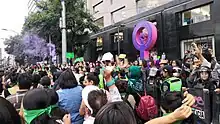The Green Wave[1] or Green Tide[1] (Spanish: "Marea verde"[2]) is a grouping of abortion-rights movements in various countries in the Americas that have collectively adopted the colour green as a symbol of their movement[1][3][4] and successfully pushed governments to expand abortion access in multiple countries across Latin America,[2][3][4][5][6] a region known for some of the strictest anti-abortion laws in the world.[2][5] While Latin America is a diverse region with a large range of abortion policies, the Green Wave has made its way across the area and has had a profound impact on abortion policies. [7]
History


Green bandanas were first adopted as a symbol by Argentinian abortion and family planning rights activists in 2003, drawing inspiration from the Mothers of the Plaza de Mayo protesters who similarly used white scarves (opponents of abortion rights in Argentina in turn began using blue bandanas as their symbol). Green bandanas were also used by Argentinian Ni una menos anti-femicide protesters in 2015. By 2020, green bandanas were being used by abortion rights proponents in several other Latin American countries. During the 2020s, multiple Latin American countries decriminalised abortion. After the Supreme Court of the United States overturned a precedent that mandated abortion access federally and multiple U.S. states began restricting abortion access as a result, abortion rights protesters in the United States also began using green as their symbol.[8] After the legalization of abortion in 4 Mexican states, the Green Wave movement continues fighting for abortion rights in Latin America[9]
Green Wave activists have contributed to the 2020 legalization of abortion in Argentina, the 2022 decriminalization of abortion in Colombia, and exemption to the abortion ban for cases of rape in Ecuador. After the Supreme Court of Mexico issued a unanimous 2021 ruling that decriminalized abortion in the country, Chief Justice, Arturo Zaldívar Lelo de Larrea, credited the Green Wave activists for shifting the national consciousness and said, "It kept getting harder and harder to go against their legitimate demands".[4]
See also
References
- 1 2 3 Herron, Madeline. "Why Green Became a Symbol of Abortion Rights Fight". NBC Chicago. Retrieved 2022-07-07.
- 1 2 3 "Latin American feminists vow to protect abortion rights at home after shock US ruling". the Guardian. 2022-05-05. Retrieved 2022-07-07.
- 1 2 "What the U.S. can learn from abortion rights wins in Latin America". NPR. Retrieved 2022-07-07.
- 1 2 3 Kitroeff, Natalie (2022-07-09). "How Mexico's Top Justice, Raised Catholic, Became an Abortion Rights Champion". The New York Times. ISSN 0362-4331. Retrieved 2022-07-09.
- 1 2 McDonnell, Patrick J.; Linthicum, Kate (2021-09-12). "Across Latin America, abortion restrictions are being loosened". Los Angeles Times. Retrieved 2022-07-07.
- ↑ "For abortion rights activists, Latin America provides a roadmap of 'long fight' ahead". NBC News. Retrieved 2022-07-07.
- ↑ "Latin America and the Caribbean". Center for Reproductive Rights. 2023-11-08. Retrieved 2023-11-13.
- ↑ Schmidt, Samantha (July 3, 2022). "How green became the color of abortion rights". Washington Post. Retrieved 2022-07-07.
- ↑ Robyns, Rebecca. "Marea Verde' Feminist Collective Defends the Right To Decide in Mexico: "Sick and Tired of Seeing Our Sisters Go to Jail". MS Magazine. Retrieved 12 September 2023.